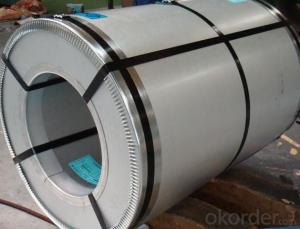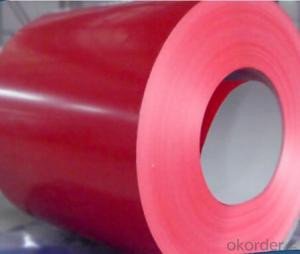Zinc Coated Gi Galvanized Steel Coil for Building
- Loading Port:
- Shanghai
- Payment Terms:
- TT OR LC
- Min Order Qty:
- 25 m.t.
- Supply Capability:
- 10000 m.t./month
OKorder Service Pledge
OKorder Financial Service
You Might Also Like
Basic Info.
Model NO.:roofing sheet
Surface Treatment:Galvanized
Technique:Cold Rolled
Standard:ASTM, JIS, GB, AISI, DIN, BS, GOST
Steel Grade:Q235
Grade:Dx51d / Dx52d/ Dx53D/ S250,280,320gd
Width:914, 1000, 1200, 1219, 1220, 1250
Base Material:Galvanized or Gavalume, Steel
Thickness:0.14mm to 1.5mm
Zinc Coating:40-150GSM
Length:up to The Thickness
Lacquer:Top Side15-25 Micro,Back Side 5 Micro
Surface:Passivation Unoiled Free Spangle Passivated
Export Markets:Global
Additional Info.
Trademark:STW or OEM
Packing:Export Seaworthy Packing
Standard:According to Your Requirement
Production Capacity:20000 Metric Tons/Month
Product Description
Specifications;
1. Aluzinc coating mass: 30g-275g/sqm
2. Coil weight:4-6 tons per coil
3. Edge treatment: Mill edge or cut edge.
4. Technical treatment: Bright annealed, flatting, cold harden.
5. Surface treatment: Annealed, bright finish, dull/bright finish, slit edge.
6. Spangle: Normal/small/big/zero spangle.
7. Delivery terms: FOB / C&R / CIF
8. Supply Ability: 30000MT/month
9. Application: The construction industry: The roof structure, keel, grill, Clapboard, ceilings, fire shutter doors, etc; The light industry, the Automobile, agriculture, animal husbandry, fishery, casing of household Electronic application, civilian smoke stack, etc.
10. Delivery time: Within 30 days after the receipt of L/C or Signed the contract or according to customer's requirement.
Special design available according to requirement; Anti-corrosion And high-temperature resistant with black painting; All the production process Are made under the ISO9001: 2000 strictly
| MOQ | 50MT |
| What knid of color we can offer | RAL not only RAL, we can provide the color according to customer' s sample |
| What is the paint? | PE, PVDF |
| What is the original material for color-coated coil? Galvanized steel coil/cold rolled coill? | PPGI(raw material GI), GI(raw material CRC) CRC( raw material HRC) |
| Surface | Regular/mini/zero spangle, chromated, skin pass, dry etc. |
| Coil Inner Diameter | 508mm |
| Strength of material ? | G550= 550 mpa, normally around 280 mpa |
| what is the range of width we can do | 750mm, 762mm, 914mm, 1000mm, 1200mm, 1219mm, 1220mm, 1250mm |
| Thickness of the zinc coating | Z40 to Z275 |
| which color is most popular? | Blue in China, brown, red, green in oversea market |
| The weight of each coils? | Normally 5Tons. We can customized 3-6Tons |
| What is the leadtime? | Normally for coils we can delivery it within 25-30 days. Depends on the quantity |
| How many years of the paint would be lasting? | Different zinc, paint coating would lead to different result, and the environment has great impact on the life time of painting. |
| Applications | With excellent cold bending molded manufacturablity, good decoration effect, strong anti-corrosion ability, galvanized steel coils and sheets are also pollution-free and easily recycled. Accordingly, they can be used as final products and basic plates of color coated steel coils and widely applied in construction, home appliances, decoration, ect. |
- Q:I need to know where to go online to buy a steel cage for a wrestling ring.. Somebody please assist me?
- the only thing you can find is a bird cage because their is no way you can buy a steel cage unless you build it yourself
- Q:What are the different types of steel coil surface defects?
- There are several different types of steel coil surface defects that can occur during the manufacturing or handling process. Some of the common types include: 1. Rust: Rust is a common surface defect that occurs when the steel coil is exposed to moisture or oxygen. It appears as a reddish-brown discoloration on the surface of the coil. 2. Scratches: Scratches are superficial marks that can occur during handling or transportation of the steel coil. They can vary in depth and severity, ranging from light surface scratches to deep gouges. 3. Stains: Stains are another type of surface defect that can occur due to exposure to chemicals or other substances. They can appear as discolored patches on the surface of the coil, and may be difficult to remove. 4. Roll marks: Roll marks are impressions or indentations that can occur during the rolling process. They are caused by uneven pressure or misalignment of the rolls, and can appear as lines or patterns on the surface of the coil. 5. Edge wave: Edge wave is a defect that occurs when the edges of the coil are not perfectly flat. It can cause the edges to appear wavy or uneven, and may affect the overall appearance and performance of the coil. 6. Oil spots: Oil spots are surface defects that occur when oil or lubricants used in the manufacturing process are not properly removed. They can appear as dark spots or patches on the surface of the coil, and may affect the adhesion of coatings or paints. 7. Pitting: Pitting is a defect that appears as small, shallow depressions or pits on the surface of the coil. It can be caused by factors such as corrosion, uneven cooling, or impurities in the steel. 8. Holes: Holes are more severe surface defects that can occur due to a variety of reasons, such as corrosion, mechanical damage, or manufacturing errors. They can range in size and can significantly affect the structural integrity of the coil. It is important to address these surface defects promptly to ensure the quality and performance of the steel coil. Regular inspections, proper handling, and appropriate surface treatments can help minimize the occurrence of these defects.
- Q:Can steel coils be stacked on top of each other?
- Yes, steel coils can be stacked on top of each other.
- Q:What is the diffrent Aluminized steel Type 1. stainless steel 409 430?
- Alloy steel is a stainless steel. The differences between the two are the composition of the metal. Alloy steel is steel with usually less than 5% of other elements, like molybdenum, copper, chrome while stainless steel is a steel with at least 10-11% of chromium.
- Q:I would like to know the process of making steel from the mining of ore to the final product. Can anybody offer some help? Either where to look, or the process itself. I would like to have included the different options with which to make steel. Through scrap metal, or iron ore briquettes etc... Thanks.
- A okorder /.. There are many different types of steels depending on process and ingredient changes that can be found in many engineering books. This will give you the basic flow.
- Q:How are steel coils used in the manufacturing of industrial compressors?
- Steel coils are used in the manufacturing of industrial compressors as they are shaped and formed into various components of the compressor, such as the casing, cylinder, and piston. The steel coils provide strength, durability, and stability to these components, allowing the compressor to withstand high pressure and perform efficiently in industrial applications.
- Q:How are steel coils used in the production of storage racks and shelving?
- Steel coils are used in the production of storage racks and shelving by being processed into flat sheets or strips, which are then formed, shaped, and welded to create the various components of the racks and shelves. The strength and durability of the steel coils make them ideal for supporting heavy loads and ensuring the stability and longevity of the storage racks and shelving systems.
- Q:What are the different methods of coating steel coils?
- There are several different methods of coating steel coils, each offering unique benefits and applications. Some of the most common methods include: 1. Hot-dip galvanizing: This process involves immersing the steel coils in a bath of molten zinc. The zinc forms a protective layer on the surface of the steel, providing excellent corrosion resistance and durability. 2. Electro-galvanizing: In this method, a layer of zinc is applied to the steel coils using an electroplating process. It provides similar corrosion resistance to hot-dip galvanizing but with a thinner coating. 3. Electro-coating (E-coating): Also known as electrodeposition, this method involves immersing the steel coils in a bath of paint or resin containing electrically charged particles. An electrical current is applied, causing the particles to adhere to the surface of the steel. E-coating provides excellent corrosion protection and is often used as a primer before applying additional coatings. 4. Powder coating: Steel coils can be coated with a dry powder paint that is electrostatically charged and then baked onto the surface. This method offers a wide range of colors, finishes, and textures, providing both aesthetic appeal and corrosion resistance. 5. Organic coatings: These coatings, such as paints or lacquers, are applied to the steel coils using various techniques like spray, roller, or dip coating. Organic coatings provide protection against corrosion, as well as offering customizable colors and finishes. Each method of coating steel coils has its advantages and is selected based on the desired level of corrosion resistance, appearance, and specific end-use requirements.
- Q:How is the thickness of a steel coil measured?
- The thickness of a steel coil is typically measured using a device called a thickness gauge or micrometer. This tool consists of a calibrated mechanical or digital system that measures the distance between two opposing surfaces of the steel coil. By placing the gauge on the coil and applying pressure, the thickness can be accurately determined.
- Q:How are steel coils protected against moisture and humidity?
- Steel coils are typically protected against moisture and humidity through various methods such as applying a protective coating or wrapping the coils with moisture-resistant materials, such as plastic or wax paper. Additionally, storing the coils in a dry and controlled environment, such as a warehouse with proper ventilation, helps prevent moisture absorption.
1. Manufacturer Overview |
|
|---|---|
| Location | |
| Year Established | |
| Annual Output Value | |
| Main Markets | |
| Company Certifications | |
2. Manufacturer Certificates |
|
|---|---|
| a) Certification Name | |
| Range | |
| Reference | |
| Validity Period | |
3. Manufacturer Capability |
|
|---|---|
| a)Trade Capacity | |
| Nearest Port | |
| Export Percentage | |
| No.of Employees in Trade Department | |
| Language Spoken: | |
| b)Factory Information | |
| Factory Size: | |
| No. of Production Lines | |
| Contract Manufacturing | |
| Product Price Range | |
Send your message to us
Zinc Coated Gi Galvanized Steel Coil for Building
- Loading Port:
- Shanghai
- Payment Terms:
- TT OR LC
- Min Order Qty:
- 25 m.t.
- Supply Capability:
- 10000 m.t./month
OKorder Service Pledge
OKorder Financial Service
Similar products
New products
Hot products
Related keywords




























